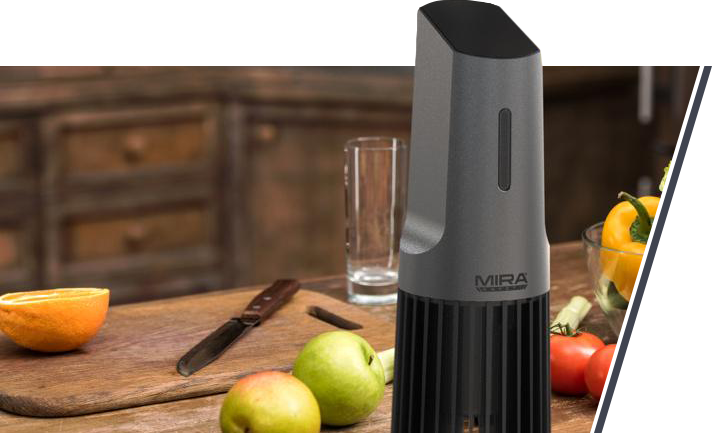When I imagine the perfect world for food, I think of the slogan for Kix cereal: "Kid-tested. Parent-approved.”

Wouldn’t it be great if all foods had that in mind?
I'm not saying we should all start nitpicking everything in our local grocery store … or that parents should be slapping away school cafeteria food.
Frankly, it would be enough if the U.S. Environmental Protection Agency (EPA) and our federal government did a better job of regulating what goes into our food crops.
Overuse of pesticides and herbicides in American crops (see our glyphosate article) demonstrates that we have a delayed response to warnings from the World Health Organization (WHO). For example, in 2015, glyphosate was labeled as a "probable carcinogen." Still, the EPA took until this year to re-evaluate the chemical after several unsettling lawsuits.
Chlorpyrifos, once a widely used pesticide, is another infamous example of when the U.S. overlooked reports from the WHO's analysis in 1999.
It was over two decades later when the troublesome chemical was banned in August 2021.

It took several petitions and lawsuits for this pesticide to get noticed. But on February 2022, it would officially go out of use and seise to show up in our grocery carts.
But there's more to this story…
There are pesticides similar to chlorpyrifos that we should grow to understand rather than fear.
And in this article, we begin with the ban that took too long, causing decades of suffering. We discuss its history, toxicity, how and why consumers were exposed, and the consequences of having this marketed poison everywhere.
There's a reason chlorpyrifos was the go-to pesticide for self-inflicted harm. It was even banned from home and garden use as early as December 2001. Yet, it was still allowed on our food crops.
Find out below how you can protect your family and take the proper precaution against these harmful chemicals.
Table of Contents
-
01
What Is Chlorpyrifos?
-
02
Toxic to Birds, Bees, and … Babies?
-
03
The Big Ban (Which Took Too Long)
-
04
Don't Wait for the EPA
-
05
Conclusion
What Is Chlorpyrifos?
Chlorpyrifos ethyl is an "organophosphate insecticide." That means it's a pesticide that damages an insect's nervous system or, in larger dosages, anything that comes in contact with it.
In its purest form, it's a colorless/white crystal and, according to studies, smells similar to rotten eggs.

First registered by the EPA in 1965 (and again in 2006), the insect killer gained marketing momentum in the hands of Dow Chemical Company and was quickly branded and sold as Dursban (home and gardening) and Lorsban (agricultural use).
According to the EPA, chlorpyrifos was the most commonly used organophosphate insecticide in the world, found in approximately 100 countries.
The EPA also discovered that approximately 21 million pounds of chlorpyrifos were used yearly in the U.S. from 1987 to 1998. And like the glyphosate trend, it skyrocketed, and everyone wanted to use it.
This pesticide was poised to annihilate all soil-born insects in agricultural, residential, and commercial areas. It gained so much popularity in 2007 that it ranked 14th among pesticide ingredients in the U.S.
Organophospha– What?

As mentioned, chlorpyrifos is considered an organophosphate insecticide. In more scientific terms, it prevents an enzyme called acetylcholinesterase from sending messages between nerve cells. And soon after entering the host (whether through ingestion or inhalation), it shuts down the nervous system, killing the insect on contact.
If that sounds like a chemical warfare agent, you’re not far off.
Organophosphates were first accidentally developed in World War II as a warfare nerve gas by Nazi Germany. The effects of chlorpyrifos are no joke … and can cause a lot of impairment to bugs, humans, and mammals alike.
That's why dosage is so critical. It heavily depends on the type of crop and pest. For example, for aphids, you would use a light spray of 20 ml. Meanwhile, pests found on fruit trees such as apples, pears, peaches, and apricots require 75 ml.
Another concern when using chlorpyrifos is that it doesn't break down well in water. It can remain in the soil for several days, weeks, or even months.

In a study from 2018, scientists Kyu-Won Hwang and Joon-Kwan Moon put together two greenhouse fields with varying amounts of chlorpyrifos on cabbage samples.
In Korea, during this time, chlorpyrifos was still being implemented to control mites, aphids, oriental tobacco budworms, apple leaf miners, and rice borers. These pests would appear on primary crops such as rice, so it was essential to find the perfect dosage of pesticide for it to be considered "regulated or safe."
The results of the experiment were mixed.
But the ultimate decision was that the safe management of this pesticide was at a 3.3 kg maximum. Otherwise, the soil would hold the pesticide for longer and affect nearby plants.
Many factors affect absorption, and as we said, the crop and pest are critical to the application, but the same goes for the soil type. The consistent result is that crops can absorb chlorpyrifos if added to the surrounding soil, which leads to concerns about pesticide water runoff and contamination of nearby vegetation.
And unfortunately, chlorpyrifos residue has a soil half-life that ranges from 11 days … to 140 days. Yikes. So, it's uncertain if the soil is still affected by chlorpyrifos. Meanwhile, the plant's surface holds residue from 10 to 14 days after application.
The critical takeaway: Wash what you eat and check the labels of what you're spraying around the house. Also, check your state regulations on pesticide and herbicide use.
Exposure to Chlorpyrifos

Chlorpyrifos was most commonly used in outdoor, public areas with lots of insect activity.
Chlorpyrifos was likely applied to regulate termites if the object outside was wooden. Think fences, utility poles, benches ... you name it. For industrial lawn areas requiring foliage maintenance, such as parks and golf courses, chlorpyrifos was also heavily used.
This miracle pest killer could terminate many soil-born bugs ranging from fire ants to roundworms to mosquitos.
That's why farmers and any occupation that required lawn or crop maintenance loved this product. You could treat feed, food crops (cotton, corn, almonds, fruit trees), and even cattle ear tags. It was an easy, universal chemical that could kill instantly.

The attractive quality of this pesticide was also its inevitable downfall.
Toxic to Birds, Bees, and … Babies?!
Chlorpyrifos lasted on the market for decades, 20 years to be precise.
But from 1965 to 2022, chlorpyrifos was a concern, and now we no longer have to worry about it in our food, water, and fields.
Getting rid of it i's something to celebrate. Yet the battle isn’t over just yet.
Because we simply can't trust our food anymore.

And that's terrifying, definitely not something you want to hear before you go pumpkin picking this Halloween. But think about the wildlife, the people, and the children exposed to a poison that caused irreparable damage.
It needs to be discussed, especially for the three significant victims of chlorpyrifos.
The Birds
Hardy Kern, the director of ABC's Pesticides and Birds campaign, was thrilled when the EPA banned chlorpyrifos on food crops. He said ABC fought for years to see the day when this deadly pesticide would no longer infringe on our food, water, and bird habitats.
ABC and Kern had worked with partner organizations such as Earthjustice, the Natural Resources Defense Council, the Center for Food Safety, United Farm Workers, and the Pesticide Action Network.
The only concern or loophole in the ruling was that chlorpyrifos could still be on food crops meant for export. ABC mentioned on its website that it wrote to the EPA Administrator Michael Regan to address the matter and to thank them for the ban.

In a study on seed-eating, white-crowned sparrows, chlorpyrifos proved to affect how they flew and their ability to migrate and reproduce. Birds traveling over long distances would often encounter winter breeding grounds covered in pesticides.
Seeds would also be affected by these harmful chemicals, which depending on the bird's size and the dosage of chlorpyrifos, would lead to possible death.
If consuming eight chlorpyrifos granules daily for three days, the poison would dramatically delay the songbirds' migration and impair migratory direction and orientation. It was either die or lose the chance to breed. These events left a significant dent in the sparrow population, which led these scientists to look further into the matter.
The Bees
Honeybees are another significant part of the ecosystem. Similar to birds, both carry pollen from place to place.
According to the Food and Drug Administration, they're not only helping the environment but are also money makers in U.S. agriculture. They produce six major products: honey, pollen, royal jelly, beeswax, propolis, and venom – all used for varying but beneficial purposes like medicine and nutrition.
These honeybees made 157 million pounds of honey in 2019 alone. The cost of its honey during this time was $1.97 per pound, resulting in about $339 million. That's no chump change.

But with honeybee diseases, the toxins from insecticides and pesticides, and pollution – it's a wonder they survived.
The good news is that according to Discover Magazine, as of 2022, they are not endangered, and beekeepers are continuing to keep the population afloat. It also helps that chlorpyrifos is no longer available because it is very toxic to bees and most wildlife, including humans.
A study on chlorpyrifos and persistent organic pollutant levels showed that it affected bees AND their natural products. The worry was that companies would take the toxic honey and sell it to consumers, who would then ingest it. As crop pollinators, they needed to carry out their jobs. Three-quarters of angiosperms rely on pollination, and so do 75% of global fruit, vegetables, and seed crops.
Bees are essential, so it was pretty alarming when a New Zealand study discovered that 17% of bee sites and 12% of bee colonies examined had chlorpyrifos residue.
Even more disturbing was that the exposure to chlorpyrifos led to reduced memory recall in these bees. They would lose smell memory, which played a crucial role in communication between colonies. If the pesticide weren't outright killing the bees, it would surely disrupt the hive and threaten their overall survival and success in pollinating.
These unfortunate side effects parallel another notable species that experiences the same costly effects.
The Babies

So, you now know about the birds and the bees. But it's essential also to know that human fetuses are no exception to the dangers of chlorpyrifos.
Mothers exposed to the pesticide found that even in their babies' umbilical cords, there were still remnants of chlorpyrifos residue.
And as we said earlier, chlorpyrifos is not readily soluble. It could last days to weeks in soil, affecting groundwater and nearby food crops. These mothers had no idea how long pesticides could stay in their system after taking just a simple bite from an apple. Who could fault them for not realizing their local grocery store had unsafe food products?
In 2011, Virginia Rauh, co-deputy director of the Columbia Center for Children's Environmental Health, proved a direct correlation between prenatal exposure to chlorpyrifos and kids with a lower I.Q. and a deficit in working memory (just like the bees and birds).
Even at low (thought-to-be "safe") levels of exposure, the pesticide still led to irreversible damage to the brains of many fetuses.
A study using male rats would also note that boys, particularly, were affected more than girls because the exposure would decrease testosterone levels. And aside from the impact on memory and I.Q., these babies would be born with lower birth weights, attention deficit disorder, autism spectrum disorder, Parkinson's disease… the list goes on.
But it's not just babies or developing fetuses.
Adults who ingested or inhaled chlorpyrifos (again, depending on the dosage) would have symptoms ranging from headaches and blurred vision to seizures, comas, and, inevitably ... possible death.
These symptoms were nothing to scoff at, yet it's a wonder how the EPA didn't react sooner to these cases. It took 20 years, but finally, change happened.
What Is Chlorpyrifos?

The New York Times turned the national spotlight onchlorpyrifos in a 2019 article titled: "How Has This Pesticide Not Been Banned?" with a subheading: "Government scientists say chlorpyrifos is unsafe. And yet it's still in use."
Three years later, chlorpyrifos was finally out of American food crops.
It took approximately 100 medical, consumer, and environmental organizations for a solution to this problem. What's even more unusual is that in 2019 the EPA proposed a complete federal ban. Yet the federal government didn’t take immediate action.
Luckily, similar to state actions against glyphosate, California and Hawaii took a confident stand on the matter and issued statewide bans. New York's State Legislature passed a bill to ban chlorpyrifos, and New Jersey was not far behind.
Chlorpyrifos was a poison that caused brain and nerve damage to children and unborn babies, yet it took thousands of voices for a final ruling to ban it.

Why was there so much resistance in 2018 between the EPA's findings on chlorpyrifos and the Trump administration?
According to NY Times, the administration blocked the release of a federal report containing the dangers of chlorpyrifos on more than 1,000 species, most already near extinction.
Chlorpyrifos has been in our water, air, and food for years.
And regardless of the revealed risks from the WHO, the EPA, and direct testimonials from victims, it still took 20 years for change to happen.
Then, Earthjustice finally sued the EPA in 2019 for, as they call it, "shirking this duty" to ensure no harm to those ingesting pesticides on food. It was the 1996 Food Quality Protection Act that reinforced their concerns.

The Ninth Circuit Court of Appeals came out on the side of Earthjustice and its many clients. It ordered that the EPA ban chlorpyrifos on food or figure out a way to regulate the chemical so that it protects rather than causes more damage.
The court refused to have another generation of American children exposed to such a toxic chemical.
This month, the EPA has decided to continue reviewing two dozen more organophosphate pesticides still on the market and in use. These actions redeem the EPA from past negligence, but what you should be concerned with today is how to protect your family now while change is still in the works.
Don't Wait for the EPA

Food is something we take for granted. And it's what we should be thankful for (especially with Thanksgiving around the corner).
It's easy to forget how fortunate we are to be able to walk down the street and buy a bag of groceries. Maybe that's why we don't stop and take the time to find out where our food comes from or what's in it.
Maybe for some, it's better to be blissfully ignorant of the hard truth, but that's when the toxic chemicals win.
The news was out there but didn’t get the recognition it deserved.
You must look for the news to protect your food and your family. You need to be curious about everyday life choices. You need to know what chemicals are on some of your favorite foods and maybe even learn about local pesticide practices in your area.
This pesticide was developed as a byproduct of chemical warfare testing. It may be out of our homes in the U.S., but what about the other dozen organophosphates still under EPA evaluation?
It's not feasible to wait for federal action to protect your family’s diet.
If you want to protect your household and your food, yet you're not interested in changing the foods you buy, there’s a solution …
MIRA Safety's DTX-1 Oxidizing Food Detoxifier Meat, Fruit, and Vegetable Wash Machine removes all toxic contaminants from carcinogens to pesticides. It can also detoxify your water and your produce.
Even better, it's straightforward to use.
You only need a bowl of water, the DTX-1, and the affected food items. You can detoxify a range of raw foods and household items as long as they fit inside the bowl.
Whether you’re worried about organophosphates or a laundry list of other pesticides, regular consumer products aren't always safe, and that's the hard truth.
But while we're struggling to determine what's "good or bad," why not take away all the risk and have peace of mind with the DTX-1? It removes all the hazards and toxins from your everyday foods. That's why it's our No. 1 go-to appliance (next to the air fryer).
Protecting Your Family From the Next Chlorpyrifos
Nothing hurts more than to have to explain to a child the dangers of something you enjoy. Food is a benefit. It's a necessity. Meanwhile, we nitpick everything about it because it's connected to our health and well-being.
Unfortunately, not everything is "kid-tested or parent-approved."
It's good to know that future generations won't have to worry about chlorpyrifos. But if we let something comparable go for so long, who says there aren't other dangers?
The ban on chlorpyrifos is just the first stepping stone for the EPA and future agriculture. And while we wait out this evolution of public awareness and the move toward greener pastures, we should also be focused on how we can protect our families today.






